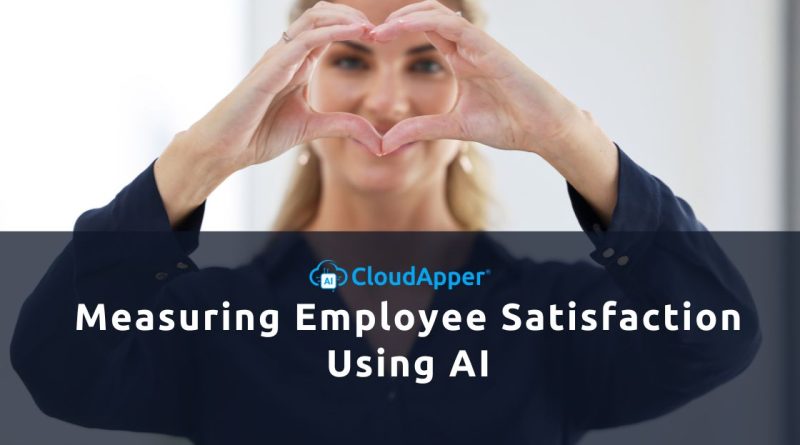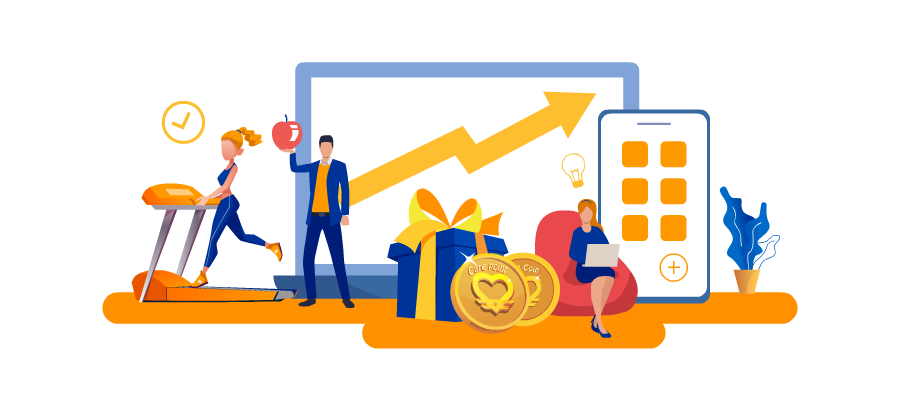The current emphasis in the contemporary corporate landscape is undergoing a transition towards the individuals who are crucial in the functioning of an organization, namely its employees. Organizations are expending significant resources to cultivate a conducive work environment that fosters employee satisfaction, engagement, and loyalty, recognizing the paramount significance of employee contentment. This comprehensive book will extensively explore the subject of employee satisfaction, encompassing several aspects like its importance, efficient measuring methods, strategies for enhancement, and the transformative impact of technology, particularly CloudApper AI, in this context.
Understanding Employee Satisfaction: A Vital Element for Success
To put it simply, employee satisfaction is a measure of how happy and fulfilled a worker is with their job and the company they work for. Engagement, well-being, and general job satisfaction can be indicated by this statistic. Reduced absenteeism and turnover are two benefits of a contented staff; increased productivity and excellence on the job are further benefits.
Work stress, work-life balance, fair remuneration, management relationships, organizational culture, opportunity for advancement, job security, and teamwork are important aspects that affect employee satisfaction. The entire landscape of job satisfaction is shaped by each of these elements.
The Impact of Employee Satisfaction on Business Performance
There is strong evidence linking happy workers to more output, according to a number of studies (including one from the University of Warwick). On average, people who are happy show 12% more productivity, and that number may go as high as 20% higher. Beyond increased productivity, there are a plethora of other benefits for organizations:
Lower Turnover Rates
Satisfied employees are less likely to seek new opportunities due to minor inconveniences. This results in decreased turnover, saving organizations both time and expenses associated with recruitment.
Higher Productivity Levels:
Content and satisfied employees are inherently dedicated, requiring minimal external motivation to excel in their roles. They willingly embrace challenges, extending beyond their defined responsibilities.
Positive Work Culture:
A satisfied workforce contributes to a positive work culture, attracting high-caliber talent and enhancing both productivity and brand image.
Improved Loyalty:
High employee satisfaction fosters loyalty. Employees who feel valued and fulfilled in their roles actively support the company’s mission.
Enhanced Brand Image:
Creating a positive and nurturing workplace atmosphere boosts employee morale, turning existing employees into advocates for the employer brand. This, in turn, attracts more top-tier talent to the organization.
Distinguishing Between Employee Satisfaction and Employee Engagement
While often used interchangeably, employee satisfaction and employee engagement represent distinct concepts, each with its unique attributes:
Employee Satisfaction:
- Definition: The level of contentment an employee feels about their job and working conditions.
- Outcome: Positive attitude and emotional well-being.
- Measurement: Employee satisfaction surveys, exit interviews, turnover rates.
- Importance: Vital for retaining employees and creating a positive workplace culture.
- Relationship: Satisfaction can lead to engagement, but not always.
Employee Engagement:
- Definition: The level of involvement, enthusiasm, and commitment an employee feels towards their job and the organization.
- Outcome: Active participation, effort, and productivity.
- Measurement: Employee engagement surveys, absenteeism rates, productivity measures.
- Importance: Critical for driving organizational success and achieving business goals.
- Relationship: Engagement can lead to satisfaction, but not always.
Factors Influencing Employee Satisfaction: Navigating the Landscape
Navigating the landscape of employee satisfaction involves understanding and addressing various factors that impact the overall employee experience:
Work Environment
A positive and supportive work culture fosters employee satisfaction, emphasizing teamwork, inclusivity, and open communication.
Job Security
A sense of job security and stability positively influences satisfaction, reducing stress related to job loss or insecurity.
Compensation and Benefits
Fair and competitive compensation, coupled with a comprehensive benefits package, contributes to employee satisfaction.
Work-Life Balance
Striking a balance between work and personal life is essential for satisfaction, with flexible working hours and leave policies supporting this balance.
Career Growth Opportunities
Opportunities for professional development and advancement contribute significantly to job satisfaction.
Recognition and Appreciation
Regular feedback, recognition, and appreciation enhance employee morale and motivation, crucial elements of satisfaction.
Job Autonomy
The level of control and decision-making power employees have over their work impacts job satisfaction.
Organizational Culture
A positive workplace culture, emphasizing open communication, collaboration, and respect, fosters a sense of belonging and satisfaction.
Respect
Feeling respected and acknowledged at work is fundamental to employee satisfaction.
Employee Engagement
Actively engaged employees are generally more satisfied, creating a symbiotic relationship between satisfaction and engagement.
Metrics for Measuring Employee Satisfaction: A Data-Driven Approach
Accurately measuring employee satisfaction requires a data-driven approach, focusing on key metrics that provide valuable insights into the overall satisfaction landscape:
Employee Net Promoter Score (eNPS)
The eNPS measures the likelihood of employees recommending the company as a place to work. Calculated by subtracting the percentage of detractors from the percentage of promoters, this score offers a clear indicator of overall satisfaction.
Formula: eNPS = Percentage of Promoters – Percentage of Detractors
Interpretation: A positive eNPS indicates satisfactory employee satisfaction, while a score below -10 raises concerns.
Glassdoor Rating
Employee satisfaction has a profound impact on employer branding, and Glassdoor serves as a popular platform for reviews. Monitoring Glassdoor ratings provides real-time insights into employee satisfaction levels.
Rating Scale:
0.00 – 1.50: Very Dissatisfied
1.51 – 2.50: Dissatisfied
2.51 – 3.50: Okay
3.51 – 4.00: Satisfied
4.01 – 5.00: Very Satisfied
Absenteeism Rate
High absenteeism rates can indicate dissatisfaction and workplace issues. Calculated by dividing the number of absent days by the number of available work days, this metric offers insights into employee well-being.
Formula: Absenteeism Rate = Number of Absent Days / Number of Available Work Days
Employee Turnover Rate
A direct correlation exists between dissatisfaction and turnover. Calculated by dividing the number of attritions by the number of employees at the beginning of a period, this metric highlights the effectiveness of employee satisfaction strategies.
Formula: Turnover Rate = Number of Attritions / Number of Employees at the Beginning of the Period
Employee Satisfaction Index (ESI)
The ESI quantifies employee satisfaction through specific questions. By calculating the mean value of responses, organizations arrive at a score between 0 to 100, indicating overall employee satisfaction.
Formula: ESI = [{(Question Mean Value / 3) – 1} / 9] x 100
Interpretation: A higher ESI reflects increased satisfaction levels.
Measuring Employee Satisfaction: Implementing Effective Strategies
Accurate measurement of employee satisfaction necessitates the implementation of effective strategies that resonate with the workforce:
Run Surveys to Measure Employee Satisfaction
Quick and easy satisfaction surveys that include both quantitative and qualitative questions given to employees on a regular basis yield useful information. Automated technologies, such as CloudApper AI, make surveys easier to administer and collect more reliable data.
Install an Employee Suggestion Box
One way to encourage open communication is to provide suggestion boxes where people may provide anonymous input. CloudApper AI uses sophisticated analytics to understand employee feedback and find useful recommendations.
Conduct One-on-One Meetings
A more individualized method of collecting targeted data is to hold regular one-on-one sessions with staff. Managers have the opportunity to inquire about employees’ emotional well-being, workload, and ideas for enhancement.
Use Proper Tools to Measure Employee Satisfaction
Manual processes are laborious and error-prone. A scalable and effective way to assess employee satisfaction is by utilizing technology, namely CloudApper AI. The steady satisfaction percentage is a result of the nuanced insights provided by advanced analytics.
Boosting Morale via Long-Term Plans
A proactive strategy is necessary to increase employee satisfaction by addressing particular pain points:
Incorporate Flexible Work Schedules
Flexibility in work hours empowers employees, reducing work stress and improving overall satisfaction.
Eliminate Repetitive Processes
Streamlining operations through automation eliminates repetitive tasks, freeing up employees’ time for more strategic contributions.
Create a Feedback Loop
Establishing open communication channels and actively seeking employee feedback contributes to a culture of transparency and continuous improvement.
Offer Training and Educational Opportunities
Prioritizing professional development opportunities demonstrates a commitment to employee growth, positively impacting satisfaction.
Practice Transparency and Accountability
Transparent communication about company milestones and decisions fosters a sense of belonging and trust among employees.
Encourage Camaraderie
Social outings and work-sponsored events encourage a sense of community, promoting job satisfaction.
Encourage Employee Development
Investing in employee development not only strengthens the workforce but also signals a commitment to their future success.
Prioritize Work-Life Balance
Emphasizing the importance of work-life balance enables employees to tackle personal concerns and return to work with renewed focus.
Challenge Employees
Setting and acknowledging new goals challenges employees, fostering a sense of accomplishment and job satisfaction.
Create Specific Objectives
Clear, realistic timelines for short- and long-term goals, coupled with regular check-ins, contribute to a sense of achievement and satisfaction.
The Role of Technology in Employee Satisfaction: CloudApper AI as the Catalyst
Technology is a game-changer in the pursuit of employee satisfaction, and CloudApper AI emerges as a transformative force. The platform’s multifaceted AI powered capabilities contribute to the entire employee satisfaction journey:
Make Employee Information Easily Accessible
CloudApper AI ensures secure 24/7 access to employee information via AI Assistant, allowing them to manage their data efficiently, including contact information and pay history.
Enable Employees to Access and Enroll in Benefits
Self-service solutions provided by CloudApper AI empower employees to access and enroll in benefits from anywhere, promoting informed decision-making.
Simplify Time and Attendance Tracking
Self-service solutions for time and attendance tracking, facilitated by CloudApper AI, enhance accuracy and provide real-time insights into PTO balances.
Continuous Feedback on Performance
CloudApper AI’s Human Capital Management (HCM) system facilitates continuous feedback collection, empowering managers to keep employees engaged and satisfied with their roles.
Employee Engagement through Technology
The use of HR self-service technology, as exemplified by CloudApper AI, connects employees to the organization. This empowers them to be accountable for their information and actively seek solutions.
Conclusion: Elevating Employee Satisfaction with CloudApper AI
Finally, strategic efforts, precise measurement, and the revolutionary potential of technology are all necessary steps on the path to employee satisfaction. At the forefront of this movement is CloudApper AI, which provides a whole suite of solutions to help businesses simplify operations, get detailed insights, and foster an environment where staff can flourish.
When it comes to improving employee satisfaction, CloudApper AI stands on four pillars: experience, competence, authority, and trustworthiness. The platform takes a data-driven strategy that surpasses conventional approaches with its smart surveys, chatbots powered by AI, sentiment analysis tools, and sophisticated analytics.
As companies progress, prioritizing employee satisfaction becomes more of a competitive advantage and a strategic need. At the forefront is CloudApper AI, which is prepared to assist businesses in making employee satisfaction more than a statistic; it will be the engine that propels them to long-term success.
Book a demo with CloudApper AI now to start this life-changing adventure and see how it improves your company’s productivity and morale.





Pingback:5 Health Tips Your Employees Will Appreciate - CircleCare